warning lights BMW CONVERTIBLE 1998 Owners Manual
[x] Cancel search | Manufacturer: BMW, Model Year: 1998, Model line: CONVERTIBLE, Model: BMW CONVERTIBLE 1998Pages: 179, PDF Size: 3.51 MB
Page 21 of 179
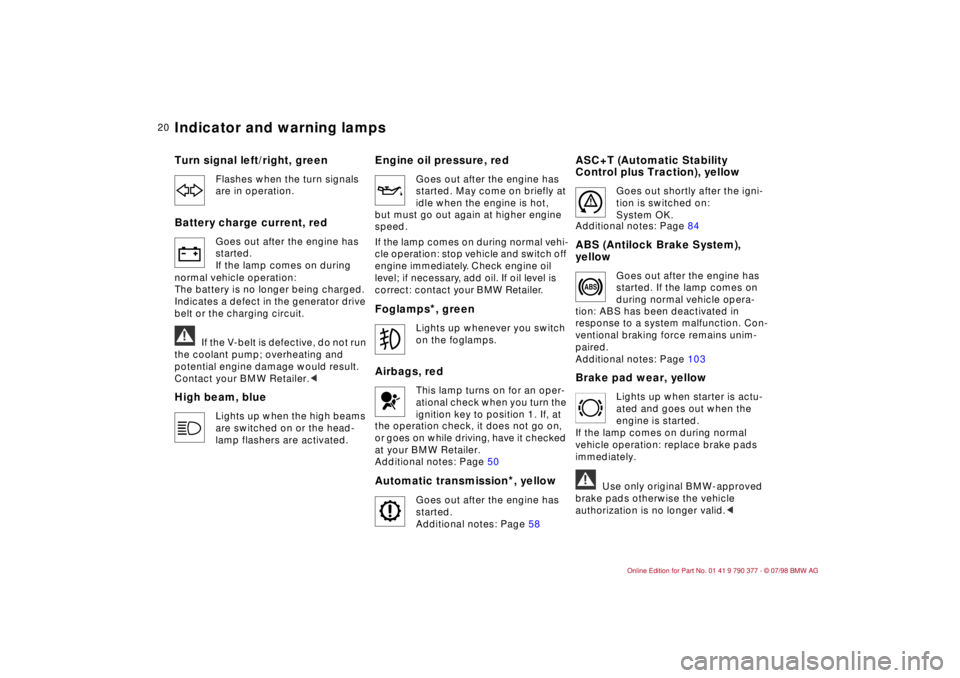
20
Turn signal left/right, green
k
Flashes when the turn signals
are in operation.
Battery charge current, red
v
Goes out after the engine has
started.
If the lamp comes on during
normal vehicle operation:
The battery is no longer being charged.
Indicates a defect in the generator drive
belt or the charging circuit.
a
If the V-belt is defective, do not run
the coolant pump; overheating and
potential engine damage would result.
Contact your BMW Retailer.
c
High beam, blue
l
Lights up when the high beams
are switched on or the head-
lamp flashers are activated.
Engine oil pressure, redw
Goes out after the engine has
started. May come on briefly at
idle when the engine is hot,
but must go out again at higher engine
speed.
If the lamp comes on during normal vehi-
cle operation: stop vehicle and switch off
engine immediately. Check engine oil
level; if necessary, add oil. If oil level is
correct: contact your BMW Retailer.
Foglamps
*, green
t
Lights up whenever you switch
on the foglamps.
Airbags, redp
This lamp turns on for an oper-
ational check when you turn the
ignition key to position 1. If, at
the operation check, it does not go on,
or goes on while driving, have it checked
at your BMW Retailer.
Additional notes: Page 50
Automatic transmission
*, yellow
O
Goes out after the engine has
started.
Additional notes: Page 58
ASC+T (Automatic Stability
Control plus Traction), yellows
Goes out shortly after the igni-
tion is switched on:
System OK.
Additional notes: Page 84
ABS (Antilock Brake System),
yellowo
Goes out after the engine has
started. If the lamp comes on
during normal vehicle opera-
tion: ABS has been deactivated in
response to a system malfunction. Con-
ventional braking force remains unim-
paired.
Additional notes: Page 103
Brake pad wear, yellow#
Lights up when starter is actu-
ated and goes out when the
engine is started.
If the lamp comes on during normal
vehicle operation: replace brake pads
immediately.
a
Use only original BMW-approved
brake pads otherwise the vehicle
authorization is no longer valid.c
Indicator and warning lamps
Page 22 of 179
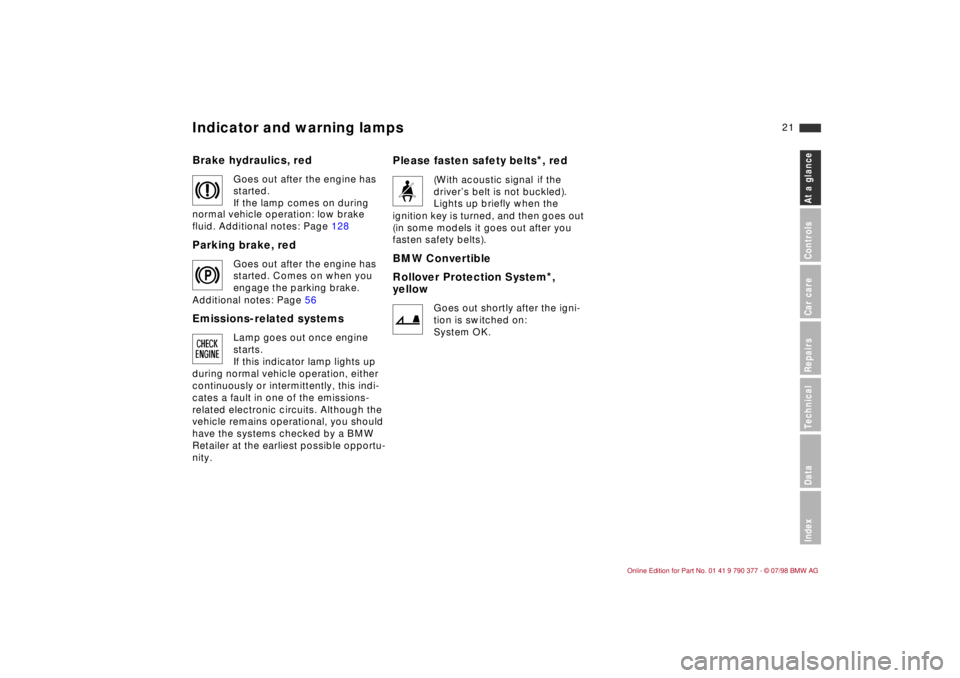
At a glanceControls Car care Repairs Technical Data Index
21
Brake hydraulics, redn
Goes out after the engine has
started.
If the lamp comes on during
normal vehicle operation: low brake
fluid. Additional notes: Page 128
Parking brake, redm
Goes out after the engine has
started. Comes on when you
engage the parking brake.
Additional notes: Page 56
Emissions-related systemsY
Lamp goes out once engine
starts.
If this indicator lamp lights up
during normal vehicle operation, either
continuously or intermittently, this indi-
cates a fault in one of the emissions-
related electronic circuits. Although the
vehicle remains operational, you should
have the systems checked by a BMW
Retailer at the earliest possible opportu-
nity.
Please fasten safety belts
*, red
q
(With acoustic signal
if the
driverÕs belt is not buckled).
Lights up briefly when the
ignition key is turned, and then goes out
(in some models it goes out after you
fasten safety belts).
BMW Convertible
Rollover Protection System
*,
yellow
;
Goes out shortly after the igni-
tion is switched on:
System OK.
Indicator and warning lamps
Page 81 of 179
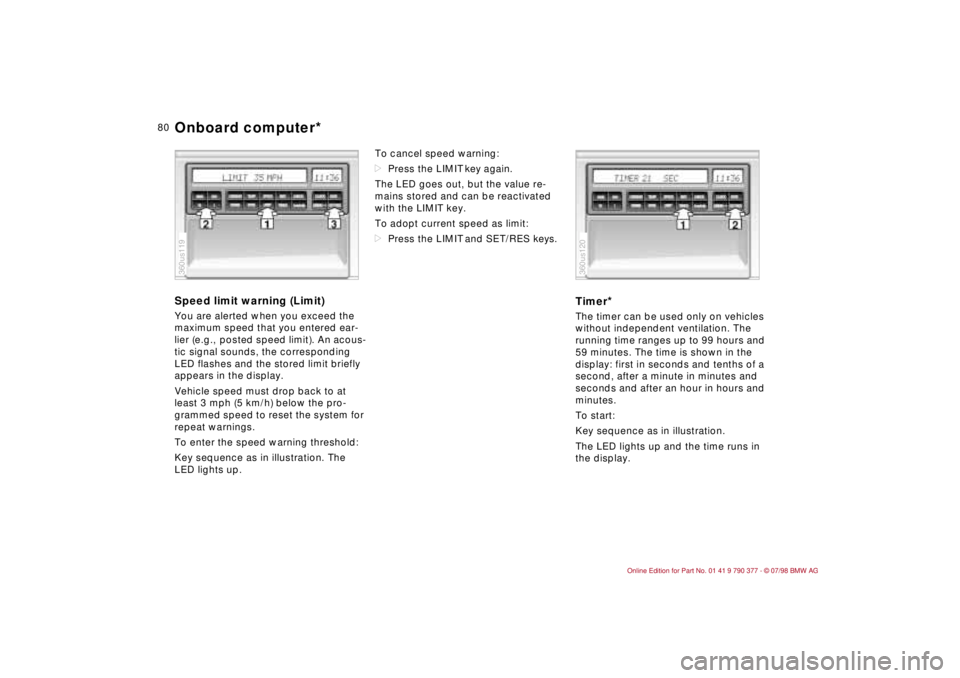
80
Speed limit warning (Limit)You are alerted when you exceed the
maximum speed that you entered ear-
lier (e.g., posted speed limit). An acous-
tic signal sounds, the corresponding
LED flashes and the stored limit briefly
appears in the display.
Vehicle speed must drop back to at
least 3 mph (5 km/h) below the pro-
grammed speed to reset the system for
repeat warnings.
To enter the speed warning threshold:
Key sequence as in illustration. The
LED lights up.To cancel speed warning:
dPress the LIMIT key again.
The LED goes out, but the value re-
mains stored and can be reactivated
with the LIMIT key.
To adopt current speed as limit:
dPress the LIMIT and SET/RES keys.
Timer
*
The timer can be used only on vehicles
without independent ventilation. The
running time ranges up to 99 hours and
59 minutes. The time is shown in the
display: first in seconds and tenths of a
second, after a minute in minutes and
seconds and after an hour in hours and
minutes.
To start:
Key sequence as in illustration.
The LED lights up and the time runs in
the display.
360us119
360us120
Onboard computer*
Page 86 of 179
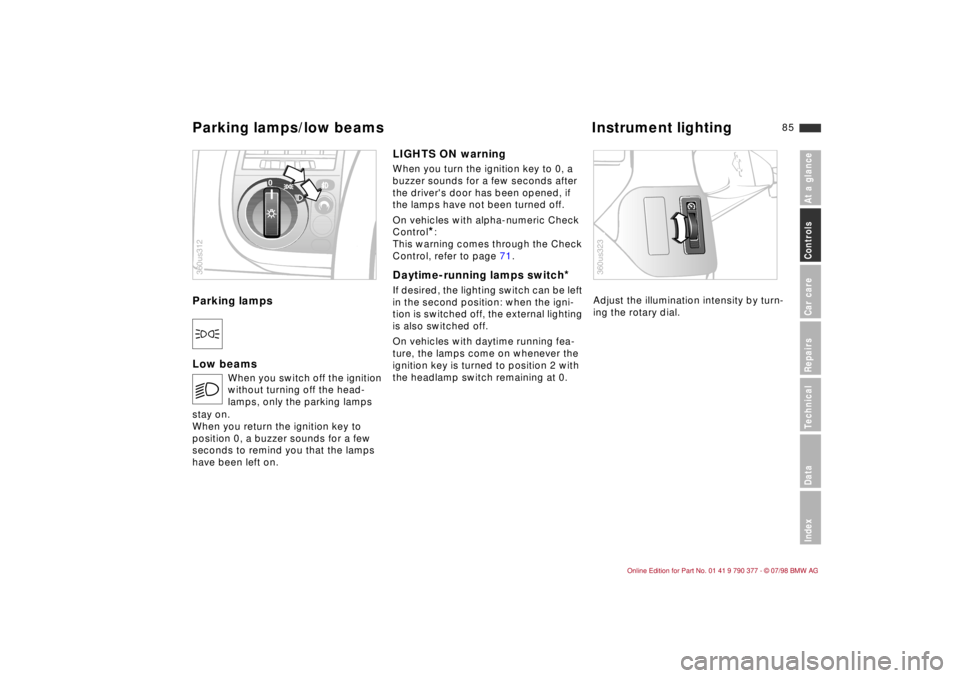
85
At a glanceControls Car careRepairsTechnicalDataIndex
Parking lampsDLow beamsLIGHTS ON warning
When you turn the ignition key to 0, a
buzzer sounds for a few seconds after
the driver's door has been opened, if
the lamps have not been turned off.
On vehicles with alpha-numeric Check
Control
*:
This warning comes through the Check
Control, refer to page 71.
Daytime-running lamps switch
*
If desired, the lighting switch can be left
in the second position: when the igni-
tion is switched off, the external lighting
is also switched off.
On vehicles with daytime running fea-
ture, the lamps come on whenever the
ignition key is turned to position 2 with
the headlamp switch remaining at 0.Adjust the illumination intensity by turn-
ing the rotary dial.
E
When you switch off the ignition
without turning off the head-
lamps, only the parking lamps
stay on.
When you return the ignition key to
position 0, a buzzer sounds for a few
seconds to remind you that the lamps
have been left on.
0
360us312
360us323
Parking lamps/low beams Instrument lighting
Page 104 of 179
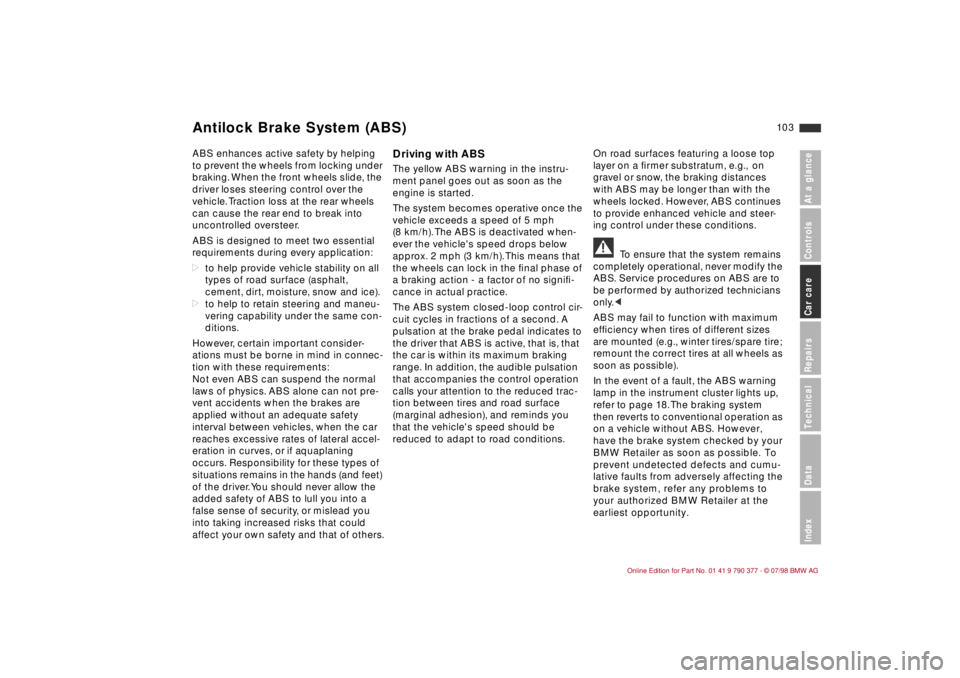
10 3
At a glanceControlsCar careRepairsTechnicalDataIndex
ABS enhances active safety by helping
to prevent the wheels from locking under
braking. When the front wheels slide, the
driver loses steering control over the
vehicle. Traction loss at the rear wheels
can cause the rear end to break into
uncontrolled oversteer.
ABS is designed to meet two essential
requirements during every application:
dto help provide vehicle stability on all
types of road surface (asphalt,
cement, dirt, moisture, snow and ice).
dto help to retain steering and maneu-
vering capability under the same con-
ditions.
However, certain important consider-
ations must be borne in mind in connec-
tion with these requirements:
Not even ABS can suspend the normal
laws of physics. ABS alone can not pre-
vent accidents when the brakes are
applied without an adequate safety
interval between vehicles, when the car
reaches excessive rates of lateral accel-
eration in curves, or if aquaplaning
occurs. Responsibility for these types of
situations remains in the hands (and feet)
of the driver. You should never allow the
added safety of ABS to lull you into a
false sense of security, or mislead you
into taking increased risks that could
affect your own safety and that of others.
Driving with ABSThe yellow ABS warning in the instru-
ment panel goes out as soon as the
engine is started.
The system becomes operative once the
vehicle exceeds a speed of 5 mph
(8 km/h). The ABS is deactivated when-
ever the vehicle's speed drops below
approx. 2 mph (3 km/h). This means that
the wheels can lock in the Þnal phase of
a braking action - a factor of no signiÞ-
cance in actual practice.
The ABS system closed-loop control cir-
cuit cycles in fractions of a second. A
pulsation at the brake pedal indicates to
the driver that ABS is active, that is, that
the car is within its maximum braking
range. In addition, the audible pulsation
that accompanies the control operation
calls your attention to the reduced trac-
tion between tires and road surface
(marginal adhesion), and reminds you
that the vehicle's speed should be
reduced to adapt to road conditions.On road surfaces featuring a loose top
layer on a Þrmer substratum, e.g., on
gravel or snow, the braking distances
with ABS may be longer than with the
wheels locked. However, ABS continues
to provide enhanced vehicle and steer-
ing control under these conditions.
a
To ensure that the system remains
completely operational, never modify the
ABS. Service procedures on ABS are to
be performed by authorized technicians
only.c
ABS may fail to function with maximum
efÞciency when tires of different sizes
are mounted (e.g., winter tires/spare tire;
remount the correct tires at all wheels as
soon as possible).
In the event of a fault, the ABS warning
lamp in the instrument cluster lights up,
refer to page 18. The braking system
then reverts to conventional operation as
on a vehicle without ABS. However,
have the brake system checked by your
BMW Retailer as soon as possible. To
prevent undetected defects and cumu-
lative faults from adversely affecting the
brake system, refer any problems to
your authorized BMW Retailer at the
earliest opportunity.
Antilock Brake System (ABS)
Page 129 of 179
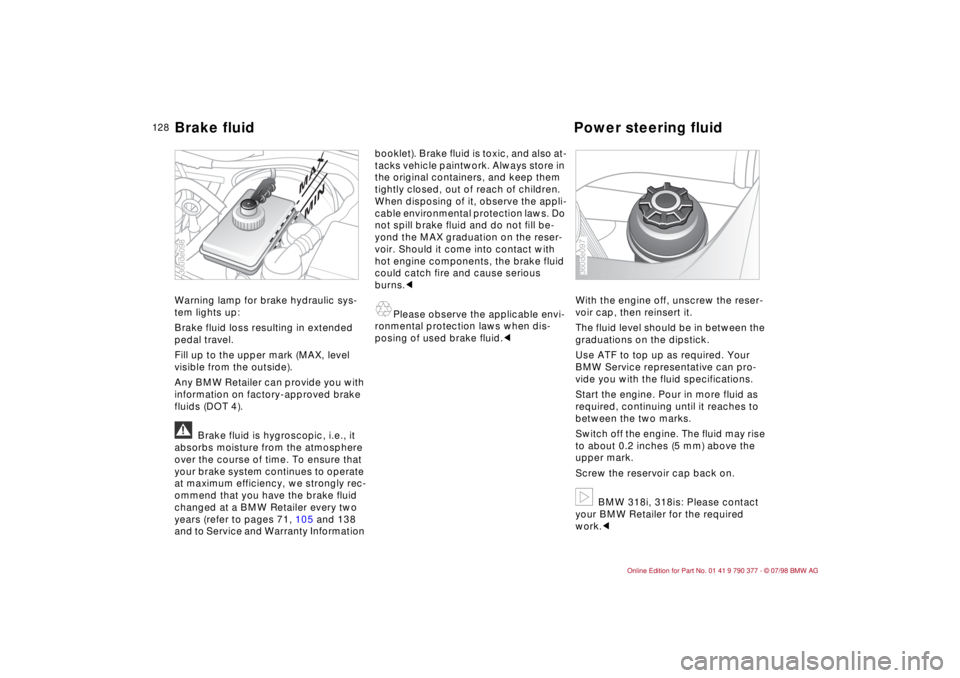
12 8
Warning lamp for brake hydraulic sys-
tem lights up:
Brake fluid loss resulting in extended
pedal travel.
Fill up to the upper mark (MAX, level
visible from the outside).
Any BMW Retailer can provide you with
information on factory-approved brake
fluids (DOT 4).
a
Brake fluid is hygroscopic, i.e., it
absorbs moisture from the atmosphere
over the course of time. To ensure that
your brake system continues to operate
at maximum efficiency, we strongly rec-
ommend that you have the brake fluid
changed at a BMW Retailer every two
years (refer to pages 71, 105 and 138
and to Service and Warranty Information booklet). Brake fluid is toxic, and also at-
tacks vehicle paintwork. Always store in
the original containers, and keep them
tightly closed, out of reach of children.
When disposing of it, observe the appli-
cable environmental protection laws. Do
not spill brake fluid and do not fill be-
yond the MAX graduation on the reser-
voir. Should it come into contact with
hot engine components, the brake fluid
could catch fire and cause serious
burns.c
A
Please observe the applicable envi-
ronmental protection laws when dis-
posing of used brake fluid.cWith the engine off, unscrew the reser-
voir cap, then reinsert it.
The fluid level should be in between the
graduations on the dipstick.
Use ATF to top up as required. Your
BMW Service representative can pro-
vide you with the fluid specifications.
Start the engine. Pour in more fluid as
required, continuing until it reaches to
between the two marks.
Switch off the engine. The fluid may rise
to about 0.2 inches (5 mm) above the
upper mark.
Screw the reservoir cap back on.
b
BMW 318i, 318is: Please contact
your BMW Retailer for the required
work.c
MAXMIN
360de098
360de097
Brake fluid Power steering fluid
Page 172 of 179
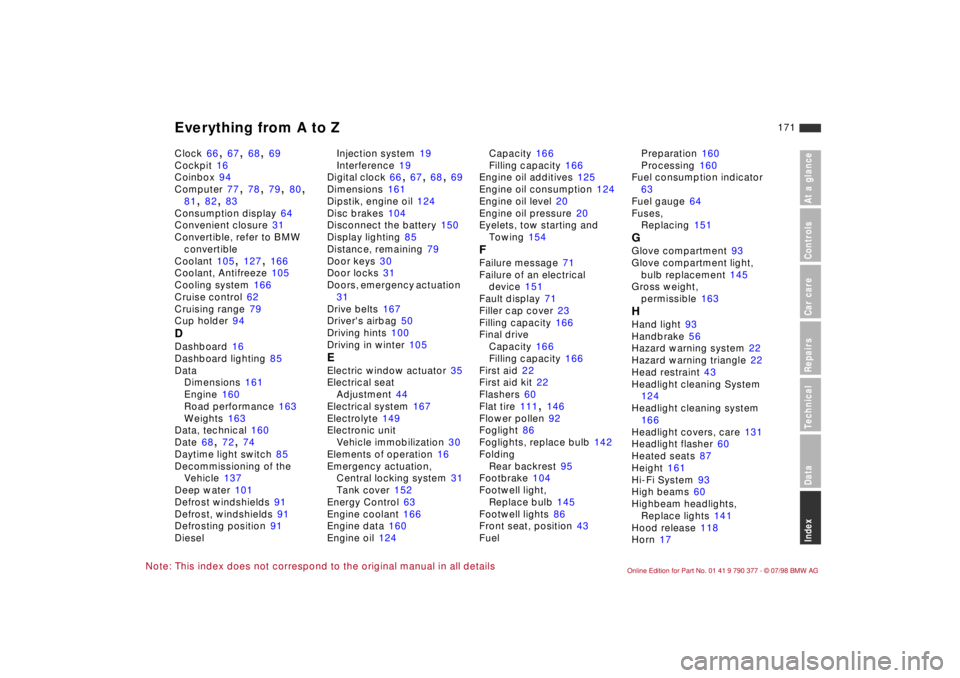
171
At a glanceControls Car careRepairsTechnicalDataIndex
Note: This index does not correspond to the original manual in all detailsClock
66
, 67
, 68
, 69
Cockpit
16
Coinbox 94
Computer 77
, 78
, 79
, 80
,
81
, 82
, 83
Consumption display
64
Convenient closure
31
Convertible, refer to BMW
convertible
Coolant
105
, 127
, 166
Coolant, Antifreeze 105
Cooling system
166
Cruise control 62
Cruising range 79
Cup holder
94
DDashboard
16
Dashboard lighting
85
Data
Dimensions
161
Engine
160
Road performance
163
Weights
163
Data, technical
160
Date
68
, 72
, 74
Daytime light switch
85
Decommissioning of the
Vehicle
137
Deep water 101
Defrost windshields
91
Defrost, windshields 91
Defrosting position 91
DieselInjection system
19
Interference
19
Digital clock
66
, 67
, 68
, 69
Dimensions
161
Dipstik, engine oil
124
Disc brakes
104
Disconnect the battery
150
Display lighting
85
Distance, remaining
79
Door keys
30
Door locks 31
Doors, emergency actuation
31
Drive belts
167
Driver's airbag
50
Driving hints
100
Driving in winter
105
EElectric window actuator
35
Electrical seat
Adjustment
44
Electrical system
167
Electrolyte
149
Electronic unit
Vehicle immobilization
30
Elements of operation
16
Emergency actuation,
Central locking system 31
Tank cover
152
Energy Control 63
Engine coolant 166
Engine data
160
Engine oil
124Capacity
166
Filling capacity
166
Engine oil additives 125
Engine oil consumption
124
Engine oil level
20
Engine oil pressure
20
Eyelets, tow starting and
Towing
154
FFailure message
71
Failure of an electrical
device
151
Fault display
71
Filler cap cover 23
Filling capacity 166
Final drive
Capacity
166
Filling capacity
166
First aid
22
First aid kit 22
Flashers
60
Flat tire 111
, 146
Flower pollen 92
Foglight
86
Foglights, replace bulb
142
Folding
Rear backrest
95
Footbrake
104
Footwell light,
Replace bulb
145
Footwell lights 86
Front seat, position
43
FuelPreparation
160
Processing 160
Fuel consumption indicator
63
Fuel gauge
64
Fuses,
Replacing 151
GGlove compartment
93
Glove compartment light,
bulb replacement 145
Gross weight,
permissible
163
HHand light
93
Handbrake 56
Hazard warning system
22
Hazard warning triangle 22
Head restraint
43
Headlight cleaning System
124
Headlight cleaning system
166
Headlight covers, care
131
Headlight flasher
60
Heated seats
87
Height
161
Hi-Fi System
93
High beams 60
Highbeam headlights,
Replace lights
141
Hood release
118
Horn
17
Everything from A to Z
Page 173 of 179
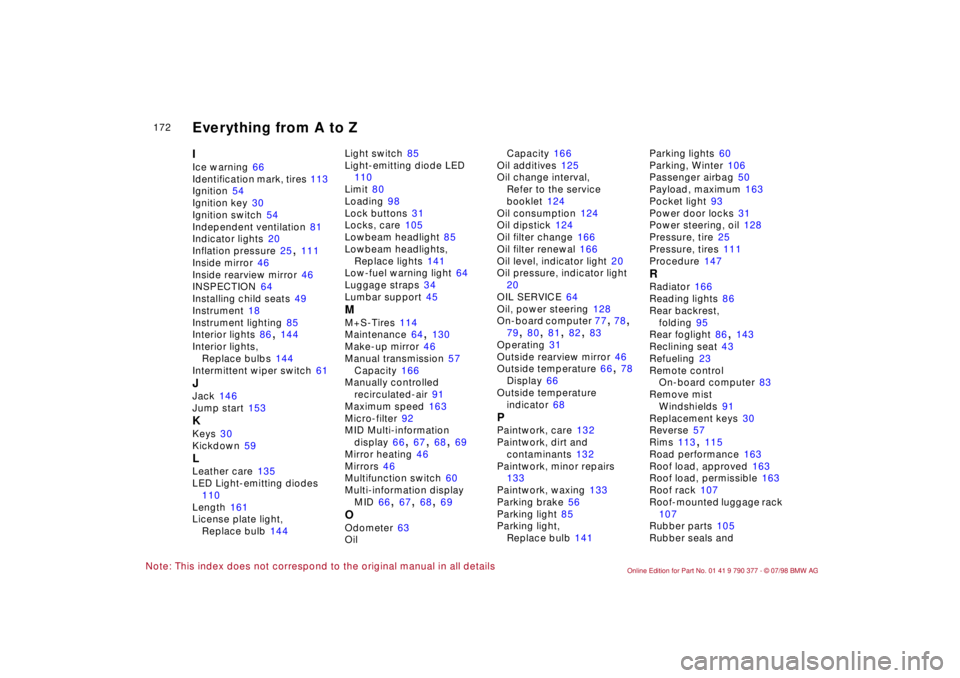
172
Note: This index does not correspond to the original manual in all details
IIce warning
66
Identification mark, tires
113
Ignition
54
Ignition key
30
Ignition switch 54
Independent ventilation
81
Indicator lights
20
Inflation pressure 25
, 111
Inside mirror
46
Inside rearview mirror
46
INSPECTION
64
Installing child seats
49
Instrument
18
Instrument lighting
85
Interior lights
86
, 144
Interior lights,
Replace bulbs 144
Intermittent wiper switch
61
JJack
146
Jump start
153
KKeys
30
Kickdown
59
LLeather care
135
LED Light-emitting diodes
110
Length
161
License plate light,
Replace bulb
144Light switch
85
Light-emitting diode LED
110
Limit
80
Loading 98
Lock buttons
31
Locks, care 105
Lowbeam headlight
85
Lowbeam headlights,
Replace lights
141
Low-fuel warning light
64
Luggage straps
34
Lumbar support 45
MM+S-Tires
114
Maintenance 64
, 130
Make-up mirror
46
Manual transmission
57
Capacity
166
Manually controlled
recirculated-air
91
Maximum speed 163
Micro-filter
92
MID Multi-information
display
66
, 67
, 68
, 69
Mirror heating
46
Mirrors
46
Multifunction switch
60
Multi-information display
MID
66
, 67
, 68
, 69
OOdometer
63
OilCapacity
166
Oil additives 125
Oil change interval,
Refer to the service
booklet
124
Oil consumption
124
Oil dipstick
124
Oil filter change
166
Oil filter renewal 166
Oil level, indicator light
20
Oil pressure, indicator light
20
OIL SERVICE
64
Oil, power steering
128
On-board computer 77
, 78
,
79
, 80
, 81
, 82
, 83
Operating
31
Outside rearview mirror
46
Outside temperature
66
, 78
Display
66
Outside temperature
indicator 68
PPaintwork, care
132
Paintwork, dirt and
contaminants 132
Paintwork, minor repairs
133
Paintwork, waxing
133
Parking brake
56
Parking light 85
Parking light,
Replace bulb 141Parking lights
60
Parking, Winter 106
Passenger airbag 50
Payload, maximum 163
Pocket light
93
Power door locks
31
Power steering, oil 128
Pressure, tire
25
Pressure, tires 111
Procedure
147
RRadiator
166
Reading lights
86
Rear backrest,
folding
95
Rear foglight
86
, 143
Reclining seat
43
Refueling
23
Remote control
On-board computer
83
Remove mist
Windshields
91
Replacement keys
30
Reverse
57
Rims
113
, 115
Road performance
163
Roof load, approved 163
Roof load, permissible 163
Roof rack
107
Roof-mounted luggage rack
107
Rubber parts
105
Rubber seals and
Everything from A to Z
Page 174 of 179
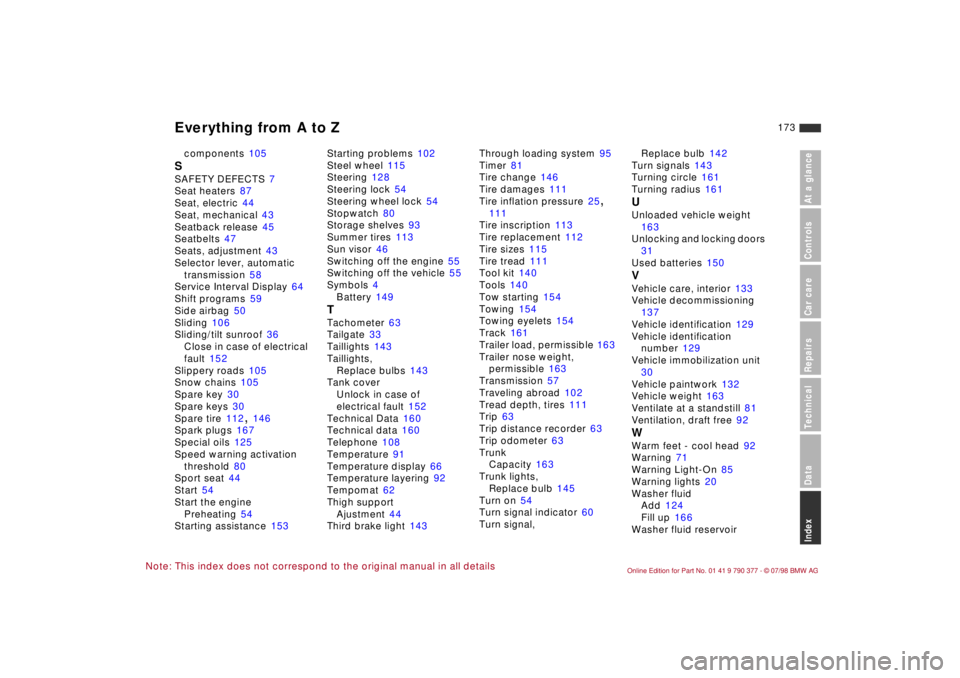
173
At a glanceControls Car careRepairsTechnicalDataIndex
Note: This index does not correspond to the original manual in all detailscomponents
105
SSAFETY DEFECTS
7
Seat heaters
87
Seat, electric 44
Seat, mechanical
43
Seatback release 45
Seatbelts
47
Seats, adjustment
43
Selector lever, automatic
transmission
58
Service Interval Display
64
Shift programs
59
Side airbag
50
Sliding
106
Sliding/tilt sunroof
36
Close in case of electrical
fault
152
Slippery roads
105
Snow chains
105
Spare key
30
Spare keys 30
Spare tire 112
, 146
Spark plugs
167
Special oils 125
Speed warning activation
threshold 80
Sport seat 44
Start
54
Start the engine
Preheating
54
Starting assistance
153Starting problems
102
Steel wheel
115
Steering
128
Steering lock
54
Steering wheel lock
54
Stopwatch
80
Storage shelves
93
Summer tires
113
Sun visor
46
Switching off the engine
55
Switching off the vehicle 55
Symbols
4
Battery 149
TTachometer
63
Tailgate
33
Taillights 143
Taillights,
Replace bulbs
143
Tank cover
Unlock in case of
electrical fault 152
Technical Data 160
Technical data 160
Telephone
108
Temperature 91
Temperature display
66
Temperature layering 92
Tempomat
62
Thigh support
Ajustment 44
Third brake light
143Through loading system
95
Timer
81
Tire change
146
Tire damages 111
Tire inflation pressure
25
,
111
Tire inscription
113
Tire replacement 112
Tire sizes
115
Tire tread 111
Tool kit
140
Tools
140
Tow starting
154
Towing
154
Towing eyelets
154
Track
161
Trailer load, permissible
163
Trailer nose weight,
permissible
163
Transmission 57
Traveling abroad
102
Tread depth, tires 111
Trip
63
Trip distance recorder
63
Trip odometer
63
Trunk
Capacity
163
Trunk lights,
Replace bulb
145
Turn on
54
Turn signal indicator
60
Turn signal,Replace bulb
142
Turn signals
143
Turning circle 161
Turning radius 161
UUnloaded vehicle weight
163
Unlocking and locking doors
31
Used batteries
150
VVehicle care, interior
133
Vehicle decommissioning
137
Vehicle identification
129
Vehicle identification
number
129
Vehicle immobilization unit
30
Vehicle paintwork
132
Vehicle weight
163
Ventilate at a standstill
81
Ventilation, draft free
92
WWarm feet - cool head
92
Warning
71
Warning Light-On
85
Warning lights
20
Washer fluid
Add
124
Fill up 166
Washer fluid reservoir
Everything from A to Z